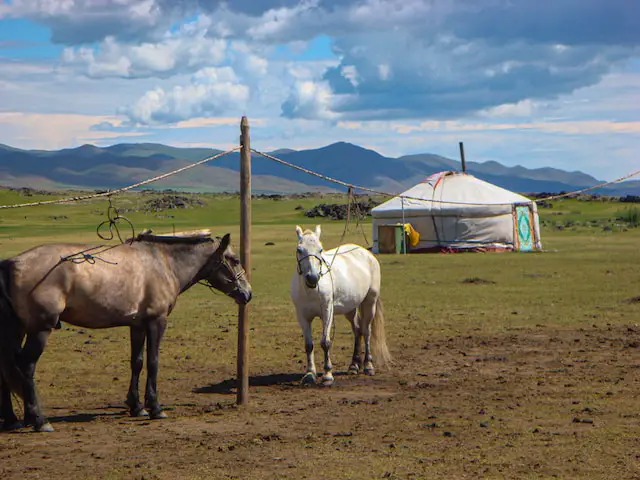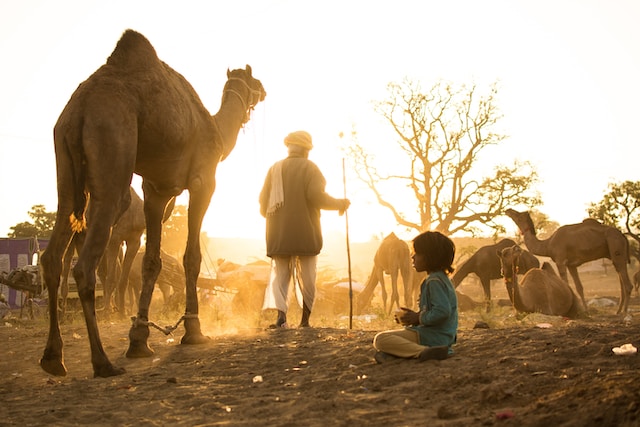Sedentary refers to a lifestyle or behavior characterized by remaining in one place or having limited physical activity, while nomadic refers to a lifestyle or behavior involving constant movement and frequently changing locations.
Sedentary lifestyles
(Photo by cottonbro studio)

Sedentary lifestyles are characterized by a lack of physical activity and an overall stationary way of living. This type of lifestyle is often associated with office jobs, long periods spent sitting down, and a general feeling of boredom. People who lead sedentary lifestyles tend to spend most of their time indoors, either at work or at home.
While there are certainly some benefits to leading a sedentary lifestyle (such as stability and consistency), it’s important to acknowledge the potential drawbacks as well. Sitting for prolonged periods has been linked to several health issues such as poor blood circulation, increased risk of heart disease, obesity and decreased flexibility.
Moreover, those who lead sedentary lives may also experience negative mental effects such as increased stress levels due to lack of movement and exposure to natural light. Additionally, being stuck in one place for extended periods can be detrimental to creativity and inspiration.
It’s essential not only for our physical but also our mental wellbeing that we find ways to break up the monotony of our sedentary routines – whether it’s through regular exercise or taking frequent breaks from sitting throughout the day.
Nomadic lifestyles
(Photo by Tengis Galamez on Unsplash )

Nomadic lifestyles are characterized by a continuous movement from one place to another. Nomads move around in search of food and water for themselves and their livestock. They build temporary shelters, such as tents or yurts, which can be quickly assembled and disassembled as they travel.
One of the key advantages of a nomadic lifestyle is that it allows people to adapt more easily to changing circumstances. For example, if food or water becomes scarce in one region, nomads can simply pack up camp and move on to greener pastures.
Another benefit of being a nomad is the sense of freedom that comes with living without permanent ties to any particular place. Nomads often have close-knit communities that support each other through shared experiences and traditions.
However, there are also downsides to living a nomadic lifestyle. One major challenge is the lack of access to basic resources like healthcare and education. Many nomadic peoples struggle with poverty due to limited economic opportunities.
Despite these challenges, many groups around the world continue to live according to traditional nomadic practices today. From Mongolian herders who roam across vast steppes with their flocks of sheep and goats, to Berber tribesmen crossing Saharan sands on camels – there are countless examples of different types of modern-day nomads who still maintain this unique way of life.
Sedentary lifestyles Vs. Nomadic lifestyles – Key differences
When it comes to lifestyle choices, two distinct ways of living come to mind: sedentary and nomadic. The key difference between these lifestyles is their level of mobility.
Sedentary lifestyles involve staying in one place for extended periods. People with this lifestyle often have a permanent home, steady employment, and regular routines. They may spend hours sitting at desks or on the couch watching TV or working on a computer. This lack of physical activity can lead to health issues such as obesity, heart disease, and diabetes.
On the other hand, nomadic lifestyles are characterized by movement from one place to another. Nomads travel frequently and do not have a permanent home base. They may live in tents or mobile homes while they move from location to location. Their daily routines often involve physical labor as they work together to set up camp and gather resources like food and water.
Nomads tend to have stronger social ties due to their reliance on community support during their travels. However, this way of life can also be challenging as it requires constant adaptation to new environments.
Whether you choose a sedentary or nomadic lifestyle depends on your personal preferences and goals. Both offer unique advantages but require sacrifices in certain areas as well.
The pros and cons of a sedentary lifestyle
Sedentary lifestyles have become increasingly common in today’s society. With advancements in technology and the availability of modern conveniences, many people find themselves leading a sedentary lifestyle without even realizing it. While there are some benefits to this type of lifestyle, there are also numerous drawbacks that should be taken into consideration.
One major advantage of a sedentary lifestyle is the increased amount of time available for work or leisure activities. Sitting for long periods allows individuals to focus on mentally demanding tasks such as computer work or writing. Additionally, those with injuries or disabilities may find that a sedentary lifestyle is easier to manage than an active one.
However, prolonged sitting can lead to numerous health problems including obesity, heart disease, and diabetes. A lack of physical activity also increases the risk of mental health issues such as depression and anxiety.
Furthermore, adopting a sedentary lifestyle often means sacrificing social interaction and outdoor activities which can lead to feelings of loneliness and isolation.
While there are some benefits associated with a sedentary lifestyle, it is important to consider the potential negative effects on both physical and mental health before fully embracing this way of living.
The pros and cons of a nomadic lifestyle
Living a nomadic lifestyle can be a thrilling and fulfilling experience that allows you to travel the world, meet new people, and explore different cultures. However, it is not without its challenges. Here are some pros and cons of living a nomadic lifestyle.
One of the biggest advantages of being a nomad is the freedom it offers. You have complete control over your schedule and can decide where to go next. This means you get to enjoy new experiences on your own terms.
Another great thing about living as a nomad is that it forces you out of your comfort zone. When we stay in one place for too long, we become stagnant; moving around keeps us engaged with life.
Moreover, by constantly changing environments, meeting new people from various backgrounds becomes more likely which leads to personal growth in all aspects.
On the flip side, one major downside of being a nomad is that it can be tough to maintain relationships since friendships inevitably end when travels take them away from each other.
Furthermore, traveling frequently can quickly add up expenses for transportations (flights) or accommodations causing financial instability if not managed properly.
Lastly but equally important , constant relocation comes with emotional exhaustion at times leading individuals feeling lost or disconnected.
While there are many benefits associated with leading an adventurous life as a nomad ,there are also significant downsides worth considering before making such decision!
How to make the transition from sedentary to nomadic (or vice versa)
Making the transition from a sedentary lifestyle to a nomadic one, or vice versa, can be quite challenging. Here are some tips on how to make the switch:
Determine your reasons for wanting to make the change. Are you seeking adventure and new experiences? Do you want to improve your health and fitness levels? Understanding your motivations will help guide your decisions.
If transitioning from sedentary to nomadic, start small by incorporating more movement into your daily routine. Take short walks around your neighborhood or try cycling instead of driving for short trips.
Research different types of nomadic lifestyles that interest you and consider trying them out for shorter periods before committing long-term.
When it comes to making the transition from nomadic back to sedentary, plan ahead financially as well as mentally. Consider what type of job you would like once returning home and begin networking before leaving the nomadic lifestyle.
Remember that there is no one “right” way to live – finding balance between being active and resting is key in any lifestyle choice.
What are some examples of nomadic peoples?
Nomadic peoples are those who move from place to place in search of food, water and shelter. They have no permanent residence and instead rely on their surroundings for survival. Here are some examples of nomadic peoples:
The Bedouins: These people are found in the deserts of Arabia and North Africa. They travel with their herds of camels, goats and sheep searching for water sources.
The Maasai: This tribe is located in Kenya and Tanzania. They are known for their traditional clothing made from brightly colored fabrics and beaded jewelry. The Maasai migrate seasonally with their cattle in search of fresh grazing land.
The Mongols: This group has a long history as nomads living across Central Asia. Their lifestyle revolved around hunting, trading, and raiding other tribes.
The Sami People: Also known as Laplanders or Saami people, they inhabit the northern parts of Scandinavia, Finland, Russia & Baltic states. They have been traditionally hunters-reindeer herders/fishermen
These groups represent just a few examples of the many different types of nomadic peoples that exist throughout the world today. Each one has its unique cultural practices that make them special in their own way!
What are some examples of Sedentary peoples?
Throughout history, many cultures have adopted a sedentary lifestyle. This means that they have settled in one location and built permanent dwellings for themselves. Some of the earliest examples of these sedentary peoples include the ancient civilizations of Mesopotamia, Egypt, and China.
In modern times, there are numerous examples of sedentary peoples around the world. One such example is the Amish community in North America. They live simple lives without modern technology and rely on farming to sustain their way of life.
Another example is urbanites living in large cities like New York or Tokyo who work long hours at desk jobs and spend most evenings relaxing at home. These individuals lead stationary lives with little physical activity beyond commuting to work.
Indigenous communities also showcase sedentary lifestyles through practices such as agriculture where people cultivate crops year-round using irrigation systems to ensure a steady source of food. Many indigenous groups also establish permanent settlements near water sources allowing them easy access to fresh water all year round.
There are countless examples throughout history and present day that highlight how humans have adapted to live a more static life over time.
Featured Image By – Jyotirmoy Gupta on Unsplash








